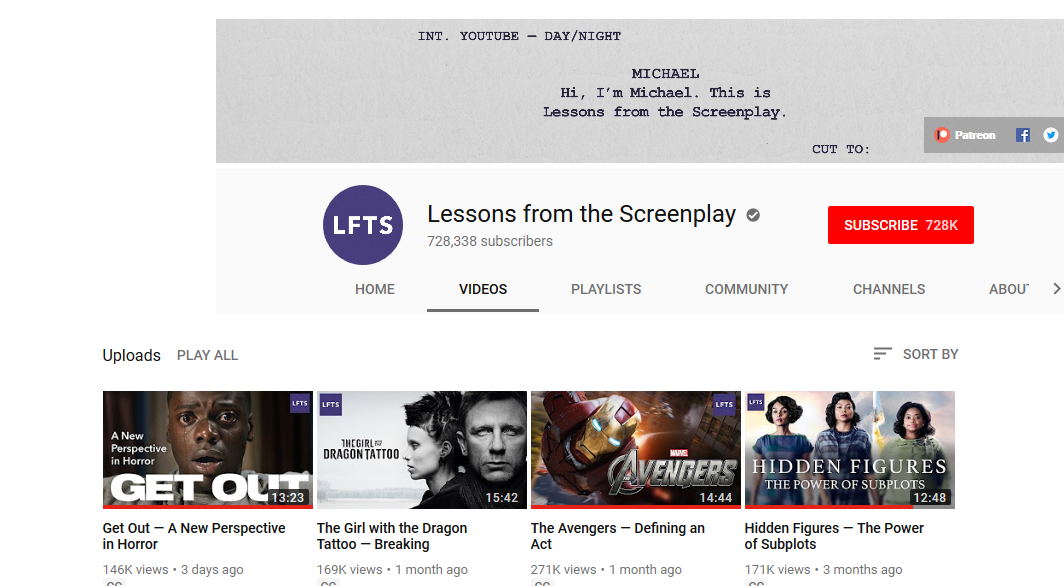I'm not a big fan of Youtube channels – I usually use it to listen to music and think that watching online videos is mostly a waste of time.
But you never know what can cause a shift in perspective – maybe it's a really nice guy saying 'hey check this out' and next thing you know, you're hooked.
It's what happened to me. Our improv teacher was telling us about this Youtube channel called Lessons from the Screenplay and about how you really could learn a lot of stuff off of it. He was telling us about their videos on American Beauty, and I figured I should check it out.
And boy, am I glad I did...
I'm the sort of person who can space out fairly easy and ignore the sounds around her, which is what happens when I watch something boring. But this time, it didn't. Not for one second. I found myself listening carefully what the voice said. And I was like 'This is so cool and makes so much sense!'
It was the beginning of a real passion, getting to the point where a nice afternoon was listening to some of these videos and either doing stuff around the house or just sitting in front of the computer, watching. Even today, I've spent the better part of the past two hours watching videos about movies.
But they're not just about movies. Here's the brilliant thing, you learn so much from this guy's observations...And you don't just learn about the movie. No, you're not just finding out an interesting fact about 'The Shining'....you're discovering a useful and interesting method to suggest something (such as creepiness, in this case).
It's fairly logical that you can learn a lot from watching movies, but it's also a generally agreed-upon concept that yeah...that's more for people who study acting or future directors...I'll just watch for the fun.
So, we don't like to focus on the techniques and on specific lines, while watching a film. Which is why we fail to see a lot of great things and important lessons. And here's where this Youtuber guy – Michael, by his name – comes into play. He explains, using shots from the film, or displaying side-by-side the text from the script with the actual movie scene, and he just...makes it so simple. So easy to follow.
And the greatest part, for me, is that they're not just helpful for aspiring filmmakers. They're amazing for aspiring writers as well. Because that's who wrote the screenplay – a writer. Makes sense, I know.
And the tricks used in screenplays, to paint characters, to show changes, to write good stories, basically, can help all of us, in our own writing.
One of the first things I learned, from this Youtuber was about the dinner scene in American Beauty. He does this brilliant thing where he defines what the scene is supposed to convey. He does so using boring dialogue that speaks everything plainly. He writes that as the scene, only to crumple it up and tell you that it would be a terrible scene.
And of course it would.
How can you love a movie if it gives everything away in the first ten seconds? If the girl tells the boy 'I despise you because you pay no attention to me and I'd really like if if you did', that brings us a lot closer to resolving the conflict. And at the same time, kills the movie. We, as viewers don't want to be told what each character's story and internal dilemma is plainly, in the beginning of the film. We want the movie to reveal that, throughout the movie. We want to understand from their actions and stares and behaviour what their attitude is towards the other person.
And this is true for readers of books and stories as well. Nobody wants to read a story that begins 'There was once this kid, Eli, who resented his father's alcoholism and hung around with losers all day, getting into trouble.'
Because then the rest of the story would just prolong and enunciate something that's been announced in the first paragraph. It wouldn't have anything new to add. Basically, they've picked your book up at the store, read the beginning and put it back down.
So, Michael then shows how the writers of American Beauty hinted at Jane's resentment for her father in a more subtle way, through her tone of voice and what she said, without actually telling him how she feels.
That's the point of any story – be it a movie, a novel, whatever – not to actually tell, but to show.
Anyway, that's just one of the great lessons you find, watching this dude's channel. He has another amazing lesson on Breaking Bad and how Walter White's story develops. What I learned? That the most character in a story is the one with the greatest potential for change. Logical, but you wouldn't have thought about it. At least, I wouldn't have.
One of my favorites is a video he did, drawing comparisons between True Detective and Se7en, in which he covers a lot of topics, such as the dynamics between protagonist and supporting characters, the realization at which the protagonist must arrive, and the lies that one tells himself to be able to live with himself.
All of these, while crucial in movies and script-writing, are crucial in the building of any good story.
With to-the-point examples, he illustrates how we learn different things about the characters and the progression of the story from less-evident details. Details that can be shown on camera, but also on page. I find I've drawn loads of valuable lessons since I started watching this guy's channel.
You learn.
Now, I don't stand to gain anything if you check his channel out, I don't know him, I don't really care. But I say this for you, if you're an aspiring writer and storyteller,
seek to learn from anything you can. Take every opportunity that presents itself.
And check it out, listen to one of his videos, while cleaning your desk or folding the laundry. It can't hurt. Worst case scenario, you've spent 15 minutes learning some interesting facts about your favorite movie. Best case scenario, you've discovered some tricks to use in your own writings, you've made it clearer in your head on what to focus next.
Thanks for reading,




